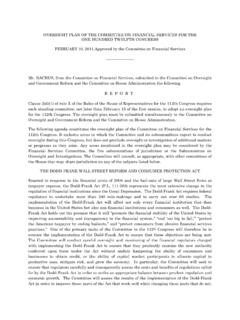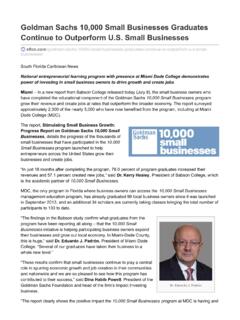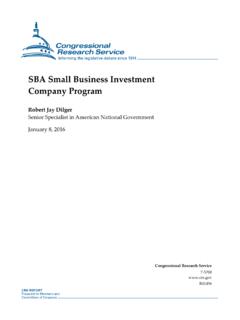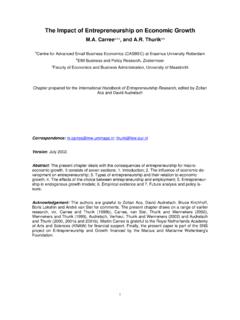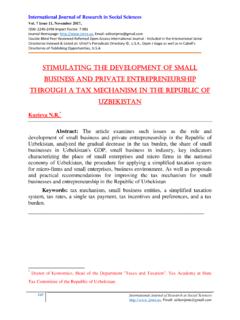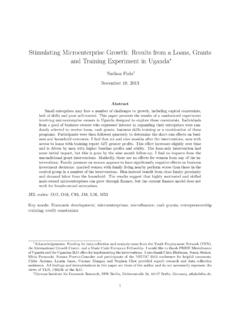Transcription of TESTIMONY OF THOMAS B. GRONSTAL On behalf …
1 TESTIMONY OF THOMAS B. GRONSTAL IOWA SUPERINTENDENT OF BANKING On behalf of the CONFERENCE OF STATE BANK SUPERVISORS On ALTERNATIVES FOR PROMOTING LIQUIDITY IN THE COMMERCIAL REAL ESTATE MARKETS, SUPPORTING small BUSINESSES AND INCREASING JOB growth Before the FINANCIAL SERVICES COMMITTEE UNITED STATES HOUSE OF REPRESENTATIVES July 29, 2010, 10:00 Room 2128 Rayburn House Office Building - 1 - Introduction Good morning, Chairman Frank, Ranking Member Bachus, and distinguished members of the Committee. My name is Tom GRONSTAL , and I serve as the Superintendent of Banking for the State of Iowa. In addition, I am the Chairman of the Conference of State Bank Supervisors (CSBS). It is my pleasure to testify before you today on behalf of CSBS. CSBS is the nationwide organization for state bank regulation, representing the bank regulators of the 50 states, the District of Columbia, Guam, Puerto Rico, and the Virgin Islands.
2 State authorities supervise approximately 6,000 state-chartered insured depository institutions, the vast majority of which are community banks. For more than a century, CSBS has given state supervisors a national forum to coordinate supervision of their regulated entities, develop regulatory policy, provide training to state officials, and represent state officials before Congress and the federal financial regulatory agencies. Today s hearing and Representative Minnick s legislation come at a crucial time for community banks and their local economies, as bank balance sheets continue to be challenged by commercial real estate (CRE) loans and the commercial real estate market continues to experience weaknesses. We appreciate the time that the Committee and that Representative Minnick, in particular, have devoted to exploring means for stabilizing the CRE market and overcoming challenges that community banks continue to face in serving this market.
3 Challenges Facing the Community Banking System The weakening of the economy has created a difficult environment for banks of all sizes. Banks are a product of the economy in which they operate and will reflect the economic conditions of those areas. In other words, if the local or national economy is - 2 - struggling, the banks operating in and serving those areas will also struggle. While the financial system appears to have been stabilized, banks will need time to restore the health of their balance sheets as the economy struggles to improve. The current economic environment has created a great deal of uncertainty in the value of commercial property and the predictability of cash flows. This uncertainty creates a challenging environment for investors and businesses, causing them to restrain capital investments and plans for expansion.
4 For lenders, it becomes very difficult to ensure collateral protection and repayment ability for both investor and owner-occupied properties. These issues are having a significant impact on the commercial real estate market, affecting the performance of existing loans, valuations on bank balance sheets, and the availability of credit. Therefore, in October 2009 CSBS joined the federal financial regulators in issuing guidance for examiners and institutions to utilize when institutions engage in CRE loan workouts. The regulators recognize that financial institutions face significant challenges when working with CRE borrowers that are experiencing diminished operating cash flows, depreciated collateral values, or prolonged sales and rental absorption periods. While CRE borrowers may experience deterioration in their financial condition, many continue to be creditworthy customers who have the willingness and capacity to repay their debts.
5 In such cases, the regulators have found that prudent CRE loan workouts are often in the best interest of the financial institution and the borrower. The guidance directs examiners to take a balanced approach in assessing the adequacy of an institution s risk management practices for loan workout activity. Based on an informal survey of my colleagues from around the country, we are beginning to see some signs of stability in loan performance and collateral values. While - 3 - the value of commercial real estate continues to decline, a significant number of states are beginning to see stabilizing CRE values. The story concerning the performance of CRE loans is a similar one. My colleagues across the states have indicated they are witnessing moderate declines or stabilization in CRE loan performance. Banks are having more success in restructuring poorly performing CRE loans across the states.
6 While many aspects of the CRE markets seem to be stabilizing, my colleagues have indicated that general demand for CRE loans is lagging and banks interest in funding new CRE loans is still low. As regulators and policymakers, we must recognize that any economic recovery will be uneven. Some regions of the nation, portions of the banking industry and some financial services markets continue to face significant challenges, despite signs of recovery in other areas. In Iowa, the number of institutions with considerable CRE concentrations has declined over the past three years. In general, CRE loan values have diminished in recent years, but not significantly. This may be a direct result of the fact that Iowa did not experience substantial inflation in the CRE markets in the years leading up to the financial crisis. In addition, public demand for CRE loans is greatly diminished and there is very little new development taking place in the state.
7 This has caused employment in the construction sectors to fall notably in the past two or three years. The regulatory guidance provided critical support for prudent restructuring of problem credits. Given where we are in the current economic cycle, we believe Congress can play an important role in the CRE market by providing a federal guarantee for prudently underwritten loans. This should help to encourage lending and enhance stability in the marketplace. - 4 - The Commercial Real Estate Stabilization Act (CRESA) As such, CSBS applauds Representative Minnick for his efforts to support community banks and stabilize the CRE market through CRESA. CSBS supports the objectives of CRESA, its focus on small and mid-size institutions and its approach of leveraging a government guarantee to incent private lending and investment activity. Federal guarantees have been effectively used to support bank lending to small businesses and farmers.
8 This can be structured to be a measured risk to support private investment and lending to further public policy and economic objectives. Further, CRESA s structure contemplates conservative lending by community banks and other institutions with the expertise and experience to engage in successful commercial real estate lending. Additionally, the program s use of a government guarantee to attract and encourage private market activity increases the likelihood of broader market benefits. CRESA contemplates providing guarantees of conservative and prudent CRE lending activity to protect taxpayers from unnecessary risk. Ultimately, implementation of CRESA could provide fuel for market stability and remove uncertainty among market participants, thereby far outweighing the cost or risk of the program by stimulating the CRE market and economic growth .
9 In terms of the program s structure and oversight, we propose that state bank regulators must be represented on the program s Oversight Board. Given CRESA s stated focus on smaller institutions, we think it important that state bank regulators as prudential regulators of a majority of smaller institutions and as regulators who are more in touch with local market and credit needs be a part of CRESA oversight. The required consultation among the federal banking regulators and with state bank regulators on regulatory accounting issues is an important step in this direction and provides a basis for a - 5 - more robust role for state regulators. State regulators oversee the vast majority of banks that will be impacted by CRESA and must have a more significant role in the program s administration. Also, the application process for CRESA should be clear and streamlined to encourage institutions to apply and to make the program as efficient as possible.
10 As we saw with the Troubled Asset Relief Program (TARP), the Secretary of the Treasury should not be vested with sole responsibility for reviewing and ultimately approving applications. An applicant institution s primary federal and, where appropriate, state prudential regulator should be part of the application review and approval. This clarity and efficiency will maximize CRESA s usage and success. One challenge banks will face in participating in the program is capital. Credit losses have strained capital positions as banks seek to work with borrowers and restructure problem loans. While it does not include a capital component, CRESA, along with initiatives such as the small business Lending Fund which this Committee and the House of Representatives recently approved, offer the prospect of encouraging lending and stimulating small business stability and growth .



